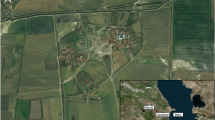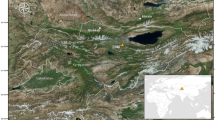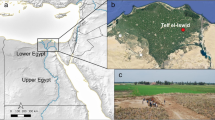Abstract
Recently, several studies have been published dealing with the analysis of plant remains from archaeological sites in the Memphite region. These investigations covered different archaeological periods. However, until now, no research has be completed on plant remains from the Early Dynastic period in this area. This paper will focus on analysis of macro-botanical remains from sealed pots discovered inside ten tombs at the Early Dynastic Cemetery in Helwan , 30 km south of Cairo (3100–2600 BC). The main goal is to study the economy and ecology relating to the site rather than the offering practices of ancient Egypt . In addition, this research will reconstruct agricultural practices, to shed light on plant diversity and to increase our understanding about non-elite lifeways that prevailed during Early Dynastic times in Memphis. Analysis of the plant remains retrieved from Helwan Cemetery has yielded a total of 25,743 fragments of charred plant macroremains. These remains were classified into two major groups: cultivated crops, including cereals, flax and legumes; and wild/weedy plants comprising wild edible fruits , field weeds, plants of moist habitats, plants of dry habitats and other indeterminate taxa. Cereal remains from the studied tombs consisted of chaff and grains. The study revealed that the arable economy of Memphis during this period was based on the cultivation of cereals primarily Hordeum vulgare L. subsp. vulgare (hulled barley) which was associated with Triticum turgidum L. ssp. dicoccum (Schrank) Thell. (emmer wheat).
Access this chapter
Tax calculation will be finalised at checkout
Purchases are for personal use only
Similar content being viewed by others
References
Barakat H (1990) Appendix IV–plant remains from El-Omari. In: Debono F, Mortensen B (eds) El-Omari: a neolithic settlement and other sites in the vicinity of wadi hof, vol 82. Archäologische Veröffentlichungen, von Zabern, Mainz am Rhein, Helwan pp 109–114
Beneš J (2011a) Analysis of wooden finds from burial shafts of AS 38. In: Vymazalová H et al (2011) Abusir XXII, The tomb of Kaiemtjenenet (AS 38) and the surroundings structures (AS 57-60). Charles University, Prague, pp 168–171
Beneš J (2011b) Xylotomic analysis of wooden objects from the embalmer’s deposit of the shaft tomb of Menekhibnekau. In: Bareš L, Smoláriková K (2011) Abusir XXV. The shaft tomb of Menekhibnekau, vol 1, Archaeology. Charles University, Prague, pp 182–184
Boulos L (1999) Flora of Egypt I. Al Hadara Publishing, Cairo
Boulos L (2000) Flora of Egypt II. Al Hadara Publishing, Cairo
Boulos L (2002) Flora of Egypt III. Al Hadara Publishing, Cairo
Boulos L (2005) Flora of Egypt IV. Al Hadara Publishing, Cairo
Boulos L (2009) Flora of Egypt checklist. Al Hadara Publishing, Cairo
Cappers RTJ, Van Thuyne T, Sikking L (2004) Plant remains from Predynastic El Abadiya-2 (Nagada area, Upper Egypt). In: Hendrickx S, Friedman RF, Clalowicz KM, Chlodnicki M (eds) Egypt at its origins: studies in memory of Barbara Adams. Orientalia Lovaniensia Analecta 138. Peeters, Leuven, pp 275–293
Cappers RTJ, Bekker RM, Jans JEA (2006) Digital seed atlas of the Netherlands. Groningen Archaeological Studies 4. Barkhuis Publishing, Eelde, Netherlands
El Hadidi MN (1993) A historical flora of Egypt, a preliminary survey. In: Davies WV, Walker R (eds) Biological anthropology and the study of Ancient Egypt. British Museum Press, London, pp 144–155
El Hadidi MN, Fahmy AG, Willerding W (1996) The palaeoethnobotany of locality 11C, Hierakonpolis (3800–3500 cal. BC); Egypt. Taeckholmia 16:45–60
El Hadidi MN, Hasan LM, Moustafa MF (1999) The phytosociological relationship between the weed flora and cultivated crops in Qena governorate. Bull Fac Sci Assiut Univ 28(2):261–278
Fahmy AG (1995) A historical flora of Egypt, Preliminary Survey. PhD Dissertation, University of Cairo, Faculty of Science, Botany Department
Fahmy AG (1997) Evaluation of the weed flora of Egypt from the Predynastic to Graeco-roman times. Veg Hist Archaeobot 6(4):242–247
Fahmy AG (2003) Palaeoethnobotanical studies of Egyptian Predynastic cemeteries: new dimensions and contributions. In: Neumann K, Butler A, Kahlheber S (eds) Food, fuel and fields: progress in African archaeobotany. contributions of the 3rd international workshop on African archaeobotany, Frankfurt, 5–7 July 2000. Heinrich-Barth-Institut, Köln, pp 95–106
Fahmy AG (2004) Insights on the development of archaeobotanical and palaeoethnobotanical studies in Egypt. In: Hendrickx S, Friedman RF, Clalowicz KM, Chlodnicki M (eds) Egypt at its origins: studies in memory of Barbara Adams. Orientalia Lovaniensia Analectavol 138. Peeters, Leuven, pp 711–730
Fahmy AG, Friedman R, Fadl M (2011) Economy and ecology of Predynastic Hierakonpolis. In: Fahmy AG, Kahlheber S, D’Andrea C (eds) Windows on the African past: current approach to African archaeobotan, Helwan, 13–15 June 2009. Africa Magna Verlag, Frankfurt, pp 91–117
Gerisch R (2007a) Main street charcoal. In: Lehner M, Wetterstrom W (eds) Giza reports: the Giza Plateau mapping project, vol 1. Ancient Egypt research associates. Hanson, Mass, pp 167–169
Gerisch R (2007b) Gallery III.4 charcoal. In: Lehner M, Wetterstrom W (eds) Giza reports: the Giza Plateau mapping project, vol 1. Ancient Egypt Research Associates, Hanson, Mass, pp 259–262
Greiss EA (1949) Anatomical identification of plant material from Ancient Egypt. Bull Institut Égyptien 3:249–283
Greiss EA (1957) Anatomical identification of some Ancient Egyptian plant materials: Mémoires présentés à l’Institut de l’Égypte 55. Cairo
Jacomet S (2006) Identification of cereal remains from archaeological sites, 2nd edn. Basel University, IPAS
Keimer L (1924) Die gartenpflanzen im Alten Ägypten. Hamburg, Berlin
Köhler EC (2008) The Helwan cemetery. Archéo-Nil 18:113–130
Köhler EC (2014) Helwan Ш–Excavation in Operation 4, tombs1-50.VML, Rahden, Westf
Köhler EC (2015) Helwan–A necropolis of Ancient Memphis. http://egyptology.univie.ac.at/fileadmin/user_upload/i_egyptology/forschung/helwan/ProjHelwanen.pdf. Accessed 15 Dec 2017
Kosinová J (1975) Weed communities of winter crops in Egypt. Preslia 47:58–74
Kroll H (1989) Die pflanzenfunde von maadi. In: Rizkana I, Seeher J (eds) Maadi III: The non-lithic small finds and the structural remains of the Predynastic settlement. Ägyptologische Abhandlungen, vol 80. Mainz, pp 129–136
Kunth C (1826) Examen botanique des fruits et des plantes. In: Passalacqua J (ed) Catalogue raisonné et historique des antiquités découvertes en Égypte. Paris, pp 227–229
Malleson C (2016) Informal intercropping of legumes with cereals? A re-assessment of clover abundance in ancient Egyptian cereal processing by-product assemblages: archaeobotanical investigation at Khentkawes Town, Giza (2300–2100 BC). Veg Hist Archaeobot 25(5):431–442
Murray M (2000) Cereal production and processing. In: Nicholson P, Shaw I (eds) Ancient Egyptian materials and technology. Cambridge University Press, Cambridge, pp 505–536
Murray M (2004) Provisions for the pyramid builders: new evidence from the ancient Egyptian site of Giza. Archaeol Intern 8:38–42
Murray M (2005) Feeding the town: new evidence from the complex of the Giza pyramid builders. General Anthropol 12(1–2):1–9
Murray M (2007a) Main street plant remains. In: Lehner M, Wetterstrom W (eds) Giza reports: the Giza Plateau mapping project, vol 1. Ancient Egypt research associates. Hanson, Mass, pp 163–165
Murray M (2007b) Gallery III.4 plant remains. In: Lehner M, Wetterstrom W (eds) Giza reports: the Giza Plateau mapping project, vol 1. Ancient Egypt Research Associates, Hanson, Mass, pp 257–258
Murray M, Gendy R (2015) A report on the Khentkawes Town—House E archaeobotanical remains. In: Sadarangani F, Witsell A (eds) Settlement and cemetery at Giza: reports from the AERA-ARCE field school. Ancient Egypt Research Associates, North Manchester, pp 237–251
Newton C (2004) Plant tempering of predynastic pisé at Adaïma in Upper Egypt: building material and taphonomy. Veg Hist Archaeobot 13(1):55–64
Newton C (2007) Growing, gathering and offering: predynastic plant economy at Adaïma (Upper Egypt). In: Cappers RTJ (ed) Fields of change: progress in African archaeobotany. Barkhuis, Groningen, The Netherlands, pp 139–155
Pokorná A (2011) Organic materials: plant remains. In: Vymazalová H et al. (2011) Abusir XXII: The tomb of Kaiemthenenet (AS 38) and the surrounding structures (AS 57-60). Charles University, Prague, pp 171–172
Pokorná A, Beneš J (2014). Plant macroremains from the old kingdom mud brick construction of the Werkaure tomb. Results of carpological and xylotomical analyses. In: Krejčí J, Arias Kytnarová K, Vymazalová H, Pokorná A, Beneš J (eds) Abusir XXIV. Mastaba of Werkaure, vol. I (Old Kingdom strata). Charles University, Prague, pp 283–293
Pokorná A, Pokorný P (2010) Organic materials: plant remains from the eastern group of mastabas. In: Bárta M (ed) Abusir XIX: tomb of Hetepi (AS 20), Tombs AS 33-35 and AS 50-53. Charles University, Prague, pp 361–370
Pokorný P, Kočár P, Sůvová Z, et al. (2009) Paleoecology of Abusir South according to plant and animal remains. In: Bárta M et al (eds) Abusir XIII: tomb complex of the Vizier Qar, His Sons Qar Junior and Senedjemib, and Iykai. Abusir South 2. Charles University, Prague, pp 29–41
Schweinfurth GA (1882) De la flore pharaonique. Bull Institut Égyptien 3:51–76
Schweinfurth GA (1883) The flora of Ancient Egypt. Nature 28:91–114
Schweinfurth GA (1884) Further discoveries in the flora of Ancient Egypt. Nature 29:312–315
Schweinfurth GA (1887) Die letzten botanischen entdeckungen in den gräbern Ägyptens. In: Engler A (ed) Botanisches jahrbücher systematic 8. Schweizerbart, Stuttgart, pp 1–15
Thanheiser U (1996) Local crop production versus import of cereals during the Predynastic Period in the Nile Delta. In: Kobusiewicz M, Kroeper K, Krzyżaniak L (eds) Interregional contacts in the later prehistory of Northeastern Africa. Archaeological Museum, Poznán, pp 291–302
Täckholm V (1939) A note on the plants found at Tanis. In: The Horticultural Review, vol 27. p 101
Täckholm V (1940) A mummy coffin in the Egyptian museum, stockholm, and its plant remains. Sven Bot Tidskr 34:141–161
Täckholm V (1951) Faraos blomster. Natur och Kultur, Stockholm
Täckholm V (1961) Botanical identification of the plants found at the monastery of Phoebammon in Thebes. Bull Société Archéologie Copte 3:1–38
Täckholm V (1974) Student’s Flora of Egypt. Cairo University Herbarium, Cairo
Täckholm V (1976) Ancient Egypt, landscape, flora and agriculture. In: Rzóska J (ed) The Nile: biology of an ancient river. Monographiae Biologicae, vol 29. Springer Netherlands, Dordrecht, pp 51–68
Täckholm V, Drar M (1950) Flora of Egypt, vol 2. Bulletin of the Faculty of Science. Fouad I University 28, Cairo
Täckholm V, Drar M (1954) Flora of Egypt, vol 3. Bulletin of the Faculty of Science. Cairo University 30, Cairo
Täckholm G, Täckholm V, Drar M (1941) Flora of Egypt, vol 1. Bulletin of the Faculty of Science. Fouad I University 17, Cairo
Unger F (1866) Botanische streifzüge auf dem gebiete der kulturgeschichte. vii. Ein ziegel der dashurpyramide in Ägypten nach seinem inhalte an organischen einschlüssen. Sitzungsberichte der Mathematisch-Naturwissenschaftlichen klasse der kaiserlichen akademie der Wissenschaften, vol 54. Wien, pp 33–62
USDA, NRCS (2016) The PLANTS database. http://plants.usda.gov. Accessed 15 Dec 2017
Van Zeist W, Roller G (1993) Plant remains from Maadi, a Predynastic site in Lower Egypt. Veg Hist Archaeobot 2:1–14
Van Zeist W, Roller G, Fahmy AG (2003) An archaeobotanical study of Maadi, a Predynastic site in Lower Egypt. In: Van Zeist W (ed) Reports on archaeobotanical studies in the old world. Groningen, Netherlands, pp 167–207
Van der Veen M (2007) Formation processes of desiccated and carbonized plant remains. The identification of routine practice. J Archaeol Sci 34:968–990
Vartavan de C (2002) Hidden fields of Tutankhamun, from identification to interpretation of newly discovered plant material from the pharaoh’s grave, 2nd edn. Triade Exploration, London
Wetterstrom W (1984) The plant remains. In: Wenke RJ (ed) Archaeological investigation at El-Hibeh 1980: preliminary report. American Research Center in Egypt reports, vol 9. Undena Publications, Malibu, California, pp 50–79
Willcox G, Fornite S, Herveux L (2002) Atlas of images of charred archaeobotanical finds. http://g.willcox.pagesperso-orange.fr/archaeobotanical%20images/index1.htm. Accessed 15 Dec 2017
Zohary D, Hopf M (1993) Domestication of plants in the Old World, 2nd edn. Clarendon Press, Oxford
Zohary D, Hopf M, Weiss E (2012) Domestication of plants in the Old World, 4th edn. Clarendon Press, Oxford, New York
Acknowledgements
We wish to express our deepest gratitude and appreciation to Prof. Dr. Christiana Köhler, Institute for Egyptology, University of Vienna, for giving the opportunity to work with her excavation team at Helwan and for using this material. Many thanks are due to the Academy of Scientific Research and Technology (ASRT), Egypt for the grant (June 2007–June 2011) which has helped in the accomplishment of this study.
Author information
Authors and Affiliations
Corresponding author
Editor information
Editors and Affiliations
Rights and permissions
Copyright information
© 2018 Springer Nature Switzerland AG
About this chapter
Cite this chapter
Moustafa, A., Fahmy, A.G., Hamdy, R.S. (2018). Archaeobotanical Study at the Early Dynastic Cemetery in Helwan (3100–2600 BC), Egypt: Plant Diversity at Early Dynastic Memphis. In: Mercuri, A., D'Andrea, A., Fornaciari, R., Höhn, A. (eds) Plants and People in the African Past. Springer, Cham. https://doi.org/10.1007/978-3-319-89839-1_2
Download citation
DOI: https://doi.org/10.1007/978-3-319-89839-1_2
Published:
Publisher Name: Springer, Cham
Print ISBN: 978-3-319-89838-4
Online ISBN: 978-3-319-89839-1
eBook Packages: Biomedical and Life SciencesBiomedical and Life Sciences (R0)




